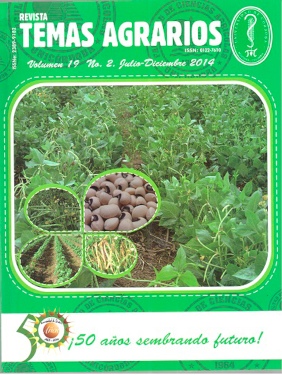Effect of different antimicrobials on the artificial diet for coffee berry borer rearing
Efecto de diferentes anticontaminantes en la dieta artificial en la cría de broca del café

This work is licensed under a Creative Commons Attribution-NonCommercial 4.0 International License.
Show authors biography
The use of antimicrobial agents in artificial diets for the mass rearing of insects is commonly employed to prevent the proliferation of environmental microorganisms, preventing contamination of food and space of the rear insects. Therefore, the aim of this research was to evaluate the effect of formaldehyde and nipagine antimicrobials on the Cenibroca artificial diet for coffee berry borer breeding. Through this experiment, using the Cenibroca diet, the largest number of coffee borer biological states per cm3 of diet was achieved, however the highest percentage of contamination by the fungi Aspergillus sp. and Penicillum sp. was obtained. When 2.65 mL of formaldehyde per liter of Cenibroca were added, the least diet contamination (3.3 %) was achieved. This addition did not affect the production of biological states of the coffee borer, in comparison with the rest of diets used, in which other antimicrobial agents were used. Based on these results, it is possible to use the Cenibroca diet in coffee berry borer breeding for the mass production of its parasitoids.
Article visits 795 | PDF visits
Downloads
- Alverson, J. and Cohen, A. 2002. Effect of antifungal agents on biological fitness of Lygus hesperus Knight (Heteroptera: Miridae). Journal Economic of Entomology 95:256-260.
- Bass, M. and Barnes, E. 1969. Toxicities of antimicrobial agents to white-fringed beetle larvae and the effectiveness of certain of these agents against microbial growth. Journal Economic of Entomology 62:718-719.
- Brun, L., Gaudichon, V. and Wigley, P. 1993. An artificial diet for continuous rearing of the coffee berry borer Hypothenemus hampei (Ferrari) (Coleoptera: Scolytidae). Insect Science and its Applications 14(5/6):585-587.
- Bustillo, P. 2008. Aspectos sobre la biología de la broca del café Hypothenemus hampei en Colombia, En: Bustillo P. A. E. (Ed), Los Insectos y su manejo en la Caficultura Colombiana. Cenicafé, Chinchiná, Caldas, p388-418.
- Cohen, A. 2004. Insect Diets: Science and Technology. CRC Press, Boca Raton.
- Gast, R. 1968. Mass rearing of insects: its concept, methods and problems, En: International Atomic Energy Agency, IEAE (Ed). Radiation, Radioisotopes, and Rearing Methods in the Control of Insect Pests. Int. Ato. Energy Agency, Vienna, p59-67.
- Parra, J. 2012. The evolution of artificial diets and their interactions in science and technology En: Panizzi, A. R. Parra, J.R. (Ed).Insect bioecology and nutrition for integrated pest management, CRC Press, Boca Raton FL, p51–92.
- Pérez, L., Bustillo, P., Gonzalez, G. y Posada, F. 1995. Comparación de dos dietas merídicas para la cría de la broca del café, Hypothenemus hampei. Cenicafé 46(4):189-195.
- Portilla, M. 1999a. Desarrollo y evaluación de una nueva dieta artificial para criar Hypothenemus hampei. Cenicafé 50(1):24-38.
- Portilla, M. 1999b. Mass rearing technique for Cephalonomia stephanoderis (Hymenoptera: Bethylidae) on Hypothenemus hampei (Coleoptera: Scolytidae) developed using Cenibroca artificial diet. Revista Colombiana de Entomología 25:57-66.
- Portilla, M. y Streett, D. 2006. Nuevas técnicas de producción masiva automatizada de Hypothenemus hampei sobre la dieta artificial Cenibroca modificada. Cenicafé 57:37-50.
- Maldonado, L. y Benavides, M. 2007. Evaluación del establecimiento de Cephalonomia stephanoderis y Proropsnasuta, controladores de Hypothenemus hampei, en Colombia. Cenicafé 58:333-339.
- Morales, J., Rojas, M., Sittertz, H. and Saldaña, G. 2000. Symbiotic relationship between Hypothenemus hampei (Coleoptera: Scolytidae) and Fusarium solani (Moniliales: Tuberculariaceae). Annals of the Entomological Society of America, 93(3):541-547.
- Sikorowski, P. and Lawrence, A. 1994. Microbial contamination insect rearing. American Entomologist 40(4):240–253.
- Singh, P. and House, H. 1970. Antimicrobials: 'safe' levels in a synthetic diet of an insect, Agriaaffinas. Journal Insect Physiology 16:1769-1782.
- Vega, F., Benavides, P., Stuart, J. J and O’Neil, S. 2002. Wolbachia infection in the coffee berry borer, Hypothenemus hampei (Ferrari) (Coleoptera: Scolytidae). Annals Entomological Society of America 95(3):374-378.
- Villacorta, A. 1985. Dieta meridica para criação desucessivas gerações de Hypothenemus hampei (Ferrari, 1867) (Coleoptera: Scolytidae). Anaisda Sociedade Entomologica do Brasil 14(2):315-319.




















